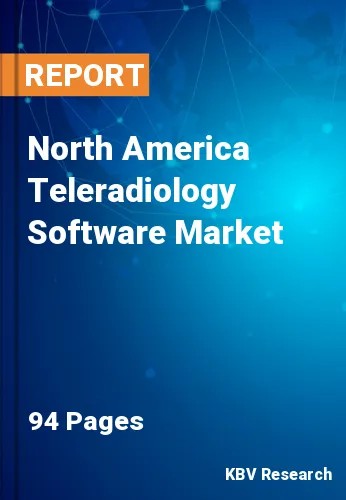The North America Teleradiology Software Market would witness market growth of 9.5% CAGR during the forecast period (2023-2030).
In emergencies, rapid access to radiological expertise is critical. Teleradiology software enables healthcare facilities to quickly transmit images to remote radiologists, ensuring that urgent cases are diagnosed promptly at night or on weekends. Some medical conditions require the expertise of specialized radiologists, such as neurologists or cardiologists. Teleradiology software enables healthcare providers to connect with these specialists for detailed consultations, leading to more accurate and comprehensive diagnoses. Integrating teleradiology software with telemedicine platforms allows for comprehensive virtual healthcare consultations. Without the need for long-distance travel, patients in remote or underserved areas can gain access to medical expertise, thus boosting healthcare accessibility.
There are also expected to be more prospects for growth in the upcoming years due to the expansion of joint ventures between governments and private businesses. Furthermore, there will likely be a rise in demand for teleradiology software due to the widespread adoption of Picture Communication and Archiving Systems (PACS). Due to the increasing demand for CT scans, diagnostic centers, medium-sized hospitals, and diagnostic clinics concentrate on acquiring specialized PACS tools. Companies that develop PACS are concentrating on the changing requirements of small hospitals. This AI-enabled transformative system provides radiologists with decision support and helps them adapt to increased workloads and exam complexity, thereby enhancing accuracy in diagnosis.
According to Canadian Institute for Health Information, the number of Canadians 65 and older is projected to increase by 68% during the next 20 years. Its size has increased by more than threefold in the last 40 years. In 2017, the population was approximately 6.2 million. It is anticipated to reach a population of 10.4 million in 2037. This population in Canada is projected to increase by 2.1 times by 2037 from its size in 2017. Elderly individuals tend to have a higher prevalence of chronic diseases and age-related conditions that require medical imaging for diagnosis and monitoring in Canada. In Canada, teleradiology enables fast image interpretation, leading to quicker diagnoses and timely treatment decisions. Due to these aspects, the market will increase across the North America region in upcoming years.
The US market dominated the North America Teleradiology Software Market, by Country in 2022, and would continue to be a dominant market till 2030; thereby, achieving a market value of $940.1 Million by 2030. The Canada market is exhibiting a CAGR of 11.9% during (2023 - 2030). Additionally, The Mexico market would experience a CAGR of 11% during (2023 - 2030).
Based on Deployment, the market is segmented into Web-based, Cloud-based, and On-premise. Based on Type, the market is segmented into Picture Archive and Communication System (PACs), Radiology Information System (RIS), and Vendor Neutral Archive (VNA). Based on countries, the market is segmented into U.S., Mexico, Canada, and Rest of North America.
Free Valuable Insights: The Global Teleradiology Software Market is Predict to reach USD 3.5 Billion by 2030, at a CAGR of 10.2%
The market research report covers the analysis of key stake holders of the market. Key companies profiled in the report include Carestream Health, Inc. (Onex Corporation), Teleradiology Solutions, Inc., Comarch SA, RamSoft, Inc., Koninklijke Philips N.V., Morton and Partners Radiologists, Everrtech Software Private Limited, Pediatrix Medical Group, Inc., Siemens AG, and Radical Imaging LLC.
By Deployment
ByType
By Country
Our team of dedicated experts can provide you with attractive expansion opportunities for your business.

